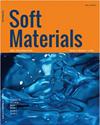Preparation and characterization of polyvinyl alcohol/ sodium alginate/carboxymethyl cellulose composite hydrogels with oriented structure
IF 1.4
4区 材料科学
Q4 MATERIALS SCIENCE, MULTIDISCIPLINARY
引用次数: 5
Abstract
ABSTRACT In order to control complex motion behavior in organisms, most biological tissues have highly oriented structures and anisotropic mechanical properties, such as articular cartilage, muscle, skin and blood vessel. In this study, inspired by the directional structure and excellent mechanical properties of biological soft tissues, polyvinyl alcohol/carboxymethyl cellulose hydrogels with different contents of sodium alginate were prepared by combining freeze-thaw and prestretching methods. Compared with SEM images without pre-stretch hydrogels, there are obvious ordered pore structures in the pre-stretch samples along the tensile direction, and the network structure becomes denser. XRD and FTI R results indicate that the introduction of SA and CMC increases the number of internal hydrogen bond and forms new covalent bonds. The tensile strength of the hydrogel without annealing and stretching treatments is only 0.41MPa. After annealing and stretching treatments, the tensile strength of the hydrogel is increased to 0.93MPa. Furthermore, the creep deformation of hydrogel was reduced from 1.08 mm to 0.27 mm by annealing and stretching treatments. To sum up, these results suggested that PVA/SA/CMC composite hydrogels with oriented structure might have potential applications in soft tissue repair and other biomaterials.定向结构聚乙烯醇/海藻酸钠/羧甲基纤维素复合水凝胶的制备与表征
摘要为了控制生物体复杂的运动行为,大多数生物组织都具有高度定向的结构和各向异性的力学性能,如关节软骨、肌肉、皮肤和血管。本研究受生物软组织定向结构和优异力学性能的启发,采用冻融和预拉伸相结合的方法制备了不同含量海藻酸钠的聚乙烯醇/羧甲基纤维素水凝胶。与没有预拉伸水凝胶的SEM图像相比,预拉伸样品沿拉伸方向具有明显的有序孔结构,网络结构变得更致密。XRD和FTIR结果表明,SA和CMC的引入增加了内部氢键的数量,并形成了新的共价键。未经退火和拉伸处理的水凝胶的拉伸强度仅为0.41MPa。退火和拉伸后,水凝胶的拉伸性能提高到0.93MPa。此外,退火和拉伸使水凝胶的蠕变变形从1.08mm降低到0.27mm。综上所述,这些结果表明,具有定向结构的PVA/SA/CMC复合水凝胶在软组织修复和其他生物材料中可能具有潜在的应用前景。
本文章由计算机程序翻译,如有差异,请以英文原文为准。
求助全文
约1分钟内获得全文
求助全文
来源期刊

Soft Materials
工程技术-材料科学:综合
CiteScore
2.90
自引率
0.00%
发文量
21
审稿时长
2.2 months
期刊介绍:
Providing a common forum for all soft matter scientists, Soft Materials covers theory, simulation, and experimental research in this rapidly expanding and interdisciplinary field. As soft materials are often at the heart of modern technologies, soft matter science has implications and applications in many areas ranging from biology to engineering.
Unlike many journals which focus primarily on individual classes of materials or particular applications, Soft Materials draw on all physical, chemical, materials science, and biological aspects of soft matter. Featured topics include polymers, biomacromolecules, colloids, membranes, Langmuir-Blodgett films, liquid crystals, granular matter, soft interfaces, complex fluids, surfactants, gels, nanomaterials, self-organization, supramolecular science, molecular recognition, soft glasses, amphiphiles, foams, and active matter.
Truly international in scope, Soft Materials contains original research, invited reviews, in-depth technical tutorials, and book reviews.
 求助内容:
求助内容: 应助结果提醒方式:
应助结果提醒方式:


